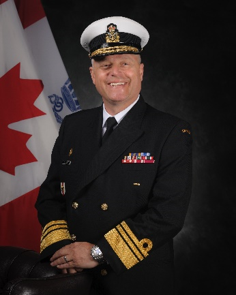March 2020 - Chief of Military Personnel - Vice-Admiral Haydn C. Edmundson
Archived content
This page was proactively published to meet the requirements of the Access to Information Act. It is a historical record which was valid when published, but may now contain information which is out of date.
Biography
- August 2019 assumed responsibilities as Chief of Military Personnel Command and Commander Military Personnel Command.
- Service includes multiple international operations, Allied Headquarters, National Canadian Headquarters positions. Within Chief of Military Personnel, multiple positions including Deputy, Chief of Staff, and Military Career Director General.

Mandate
Mission
- To recruit, train and educate, prepare, support, honour and recognize military personnel and their families for service to Canada.
Priorities:
- Recruitment and Retention: Generate the force and support to deliver on Government of Canada direction (domestic and deployed) operations and exercises
- Transition: Ensure successful transition to civilian life for all military members
- Support to military families: Create and maintain support for military families
Key facts
Total Employees:
- ~3,610 civilians
- ~7,180 military (~5,050 Regular Force, ~2,130 Reserve Force)
- 9,872 Basic Training List (BTL)
- 876 Advanced Training List (ATL)
Budget:
- $6.677B for Fiscal Year 2019-2020, $5.376 B of which is for Corporate Regular and Reserve Force Pay and Allowances.
Primary location(s):
- National Defence Headquarters Carling
Key Partners
Internal:
- All Defence Team
External:
- Veterans Affairs Canada
- Treasury Board of Canada
- Department of Justice Canada
- Canadian Institute for Military and Veteran Health Research
- The Technical Cooperation Program
- Five-Eyes partners
- Library and Archives Canada
Top issues for Chief Military Personnel
Policy and Legal Compliance
The legacy of imperfect past and current policies has resulted in class action, and mass tort lawsuits from groups that have faced discrimination. Other legal actions against the CAF are products of high profile cases of misconduct involving CAF members. The most prominent examples of legal action and policy redesign include:
- Class action lawsuit “Heyder-Beattie”
- [REDACTED]
- LGBT Purge
- [REDACTED] Transition
- Mefloquine Mass Tort Lawsuit (upcoming)
- Revised Universality of Service policy
Balancing the Force
In order to ensure that the composition of the CAF meets the spectrum of operational requirements, CMP has undertaken a number of recruiting and retention focused initiatives such as:
- KAIROS-PASSANT -- targeted recruiting for critical Naval Occupations using the Great Lakes Deployment of HMCS St. John’s
- Adaptive Career Path development
- Closing the Seam Submissions
- CAF Retention Strategy
- Supporting Op EXPERIENCE
- Trained Pilot and Technician Retention
Compensation and Benefits
Compensation and benefits are a critical component of supporting CAF personnel. CMP is making proactive changes in this area to ensure fairness and efficiency.
As an example, CMP is reviewing the way in which members are compensated for relocating.
Other examples include:
- Taxation on Casualty Benefits
- Omnibus Pay
- Pensions Report
- Post Living Differential Relocation Policy
- CAF Service Medal Modernization
Innovation and Service Delivery
CMP is making changes to the ways military personnel access support services such as career transition tools, geographical relocation, compensation and benefits programs such as:
- Brookfield Global Relocation Services Contract
- Launch of online Transition Tools
- Modernization and automation of Regular and Reserve Compensation and Benefits processes
- Canadian Forces Health Care Services Modernization
- Modernized digital recruiting platforms
- Transition Group Trial
- Renegotiation of rates with provinces for 3rd party health service delivery
Page details
- Date modified:

